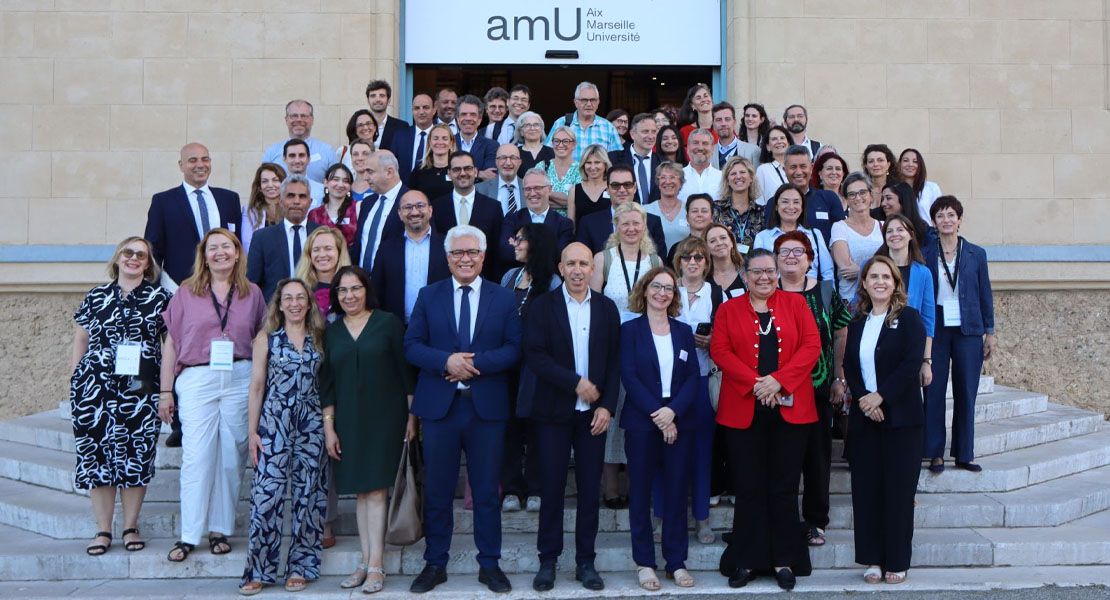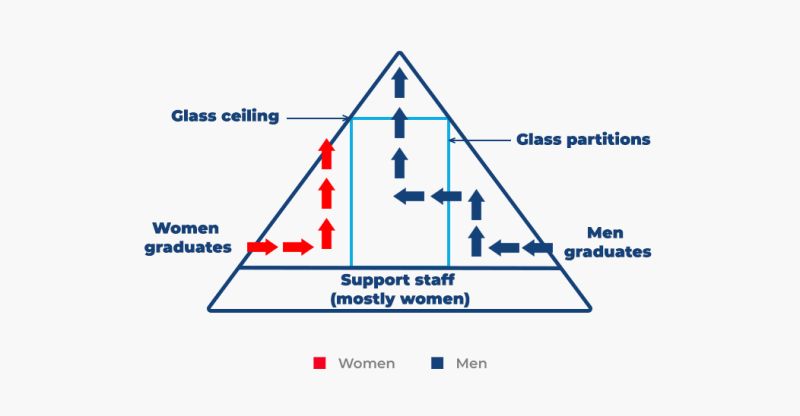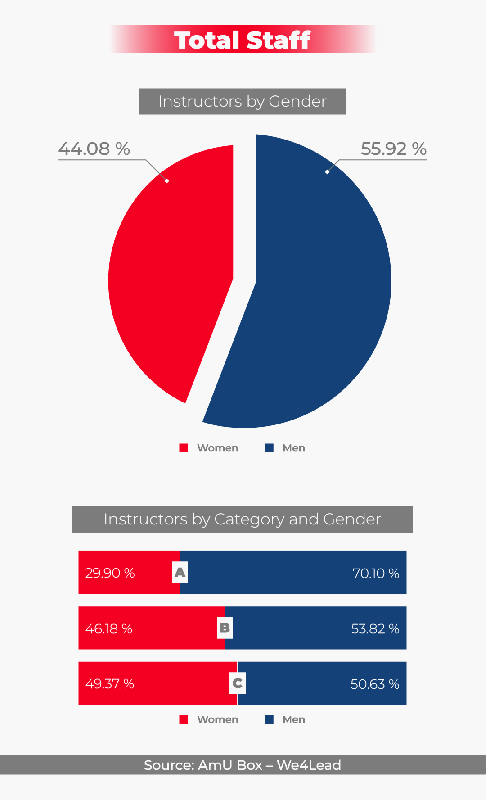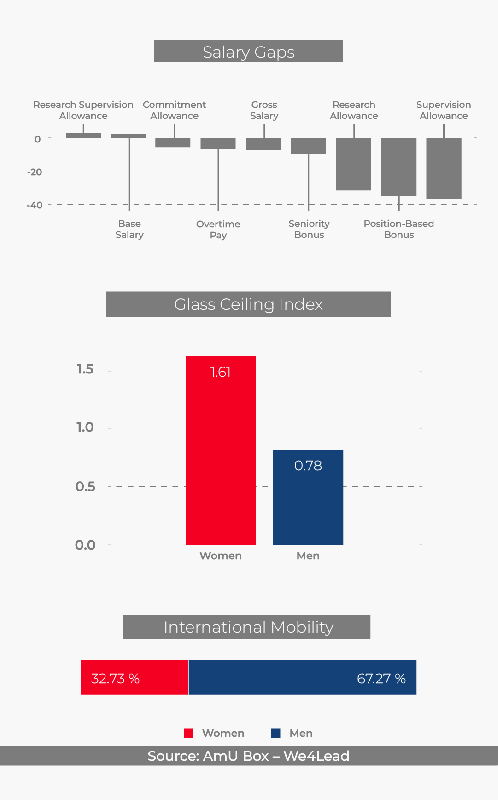
Two years after its launch, the Euro-Mediterranean WE4LEAD project has achieved tangible progress in promoting gender equality in higher education. By collecting gender-disaggregated data, establishing gender equality units, implementing anti-harassment measures, and providing leadership training, this Erasmus+ program has deeply engaged its nine partner universities. Together, they are paving the way for meaningful cultural and institutional transformation.
Two Years After Its Launch in 2023, Where Does the Euro-Mediterranean Project Women’s Empowerment for Leadership and Equity in Higher Education Institutions (WE4LEAD) Stand?
The project’s mission is to increase the representation of women in key academic leadership roles by transforming institutional practices and fostering a genuine culture of gender equality.
“This is not just another gender equality project but an initiative offering tangible actions,” stresses Isabelle Régner, WE4LEAD coordinator at Aix-Marseille University, in a presentation video on the project’s official website.
Led by the TETHYS consortium, coordinated by Aix-Marseille University and co-managed by the Lebanese University (LU), WE4LEAD unites nine higher education institutions, including universities from Lebanon (Antonine), Tunisia (Tunis El Manar and Sousse), Algeria (Constantine 1 and 3), Spain (Autonomous University of Madrid), and Italy (Sapienza).*
In 2024, This is Beirut interviewed key stakeholders to highlight the project’s approach, timeline, and task allocation. We now revisit the initiative to track progress, uncover challenges, and share results.
Measuring Inequality: Insights from Gender-Disaggregated Data
“Women face double discrimination in the labor market: horizontal segregation, being concentrated in certain sectors, and vertical segregation, struggling to access leadership roles,” explains Huguette Abou Mrad, WE4LEAD coordinator at Antonine University (AU). “The glass ceiling limits their advancement to key positions.”

This figure illustrates the career progression of male and female graduates within the same academic environment.
“The essential first step was to establish a clear baseline on women’s representation in university governance,” says Sélim Mekdessi, WE4LEAD coordinator at LU.
Key gender equality indicators, including staffing levels, wage gaps, international mobility, and senior leadership representation (glass ceiling index), were identified and measured across all partner institutions.
Data reveals women’s underrepresentation in overall staff numbers, which is even more pronounced in Category A, the highest and most prestigious faculty rank.

Salary gaps stem more from unequal access to bonuses and leadership roles than from base pay differences. Factors include recruitment and promotion biases, as well as women’s lower participation in international mobility programs, often due to family responsibilities limiting their academic advancement.

To address this, a gender data manual and targeted training were developed to help universities systematically collect and analyze data as part of an ongoing improvement process.
This tool provides a clear baseline and enables tracking of progress during and beyond the project. Quantifying inequalities also helps overcome denial or lack of awareness within institutions.
Raising Awareness, Providing Training, and Driving Change
To combat implicit gender biases influencing evaluation, promotion, and hiring, targeted training modules were introduced. Delivered via guides and interactive workshops, these resources provide practical tools such as tests, videos, presentations, and explanatory materials in French and English.
A significant milestone: “For the first time in our university’s history, we have a female vice-president!” announces Boutheina Ben Hassine, WE4LEAD coordinator at the University of Sousse. “To challenge gender stereotypes and support women’s access to academic leadership, the university offers two training tracks tailored to Tunisia’s social context,” she adds.
The first focuses on implicit gender bias in recruitment and promotion, training 40 women and 10 men from the academic and administrative staff.
The second centers on leadership and mentoring, supporting female academics - including doctoral candidates, postdocs, and lecturers - through mentorship from both male and female mentors. The program guides mentees in preparing habilitation to supervise research (HDR) applications and publishing scientific articles.
“This training also includes a proactive recruitment module encouraging women to apply for leadership positions such as department heads, scientific council members, deans, and university presidents,” says Ben Hassine.
At LU, awareness campaigns target academic and administrative leaders, selection committees, professors, and students, explains Mekdessi. “These discussions have opened vital conversations about unconscious bias, implicit selection criteria, and the barriers that sometimes unintentionally hinder women’s career advancement.”
AU has implemented multiple initiatives: “annual gender equality campaigns, awareness and training programs, and mentoring and support for women,” says Abou Mrad. “These trainings are essential and must continue, especially since successful inclusion policies require thoughtful and committed involvement from all members,” she adds.
Anti-Harassment Units to Ensure Safety for All
“Violence against women remains pervasive in both public and private spheres,” states Halima Ouanada, WE4LEAD coordinator at the University of Tunis El Manar. She highlights that anti-harassment units focus on three pillars: raising awareness among university stakeholders about sexist and sexual violence; training administrative staff to identify, respond to, and prevent such incidents; and offering confidential, compassionate support to victims in a safe environment.
This initiative draws on two surveys conducted among university governance, faculty, and students from partner countries.
The project guide provides a detailed checklist for establishing effective anti-harassment units and offers recommendations and best practices based on existing models in other institutions.
Gender Equality Units: Driving Institutional and Cultural Change
To help universities translate gender equality commitments into actionable policies, a practical guide outlines an 11-step roadmap for creating and running gender equality units. This process begins with a clear institutional pledge and ends with evaluating implemented measures.
The first step is appointing a dedicated, representative team with a clear mandate and measurable objectives. Once established, the unit conducts a comprehensive gender audit combining statistical and qualitative analyses. This diagnostic phase forms the basis for a Gender Equality Action Plan (GEAP).
“A GEAP is a strategic roadmap built around four key phases: diagnosis, planning, implementation, and evaluation,” explains Clelia Rossi Arnaud, professor at Sapienza University of Rome.
“The initial diagnosis, based on gender-disaggregated data, is crucial for identifying inequalities,” says Arnaud. “During planning, clear goals and targeted actions are defined to address these disparities.” Following implementation, continuous monitoring and impact assessment are essential. “Evaluation is not an endpoint, but the starting point of the next cycle; lessons learned inform the next diagnostic and planning stages,” she adds.
The guide encourages equality units to work closely with university leadership, communicate commitments campus-wide, oversee initiatives, and monitor outcomes.
To ensure sustainability, it recommends formally integrating units into administrative structures, securing dedicated budgets, and embedding ongoing training to withstand staff turnover.
At AU, necessary resources have been allocated to implement GEAPs, says Abou Mrad. The university has adopted multiple strategies to embed gender equality institutionally, including recruitment and promotion policies, as well as integrating gender perspectives into curricula via language courses, citizenship training, and MOOCs.
A Collective and Sustainable Momentum
WE4LEAD is much more than a skills transfer initiative. As Mekdessi notes, “It is founded on a spirit of exchange and collaboration, where each partner university brings its perspectives, challenges, and solutions.”
Beyond its nine founding institutions, the project seeks to spread its results and promote adoption of its transformative practices by other universities and public and private organizations committed to gender equality. The aim is to ensure these achievements endure and extend well beyond the academic realm.
A key partner is the Francophone Network of Women Leaders in Higher Education and Research (RESUFF), which plays a vital role in sustaining progress. Led by its scientific committee president, Leila Saadé, RESUFF facilitates institutional exchange, shares best practices, and ensures the project’s impact continues beyond its official timeline. For example, the March 2025 webinar during Women’s Month showcased key advances and broadened dialogue to other Francophone academic settings.
And the results are clear. “They are starting to emerge,” observes Mekdessi. “Awareness is growing, even among decision-makers. People are more willing to recognize and challenge inequalities. Most importantly, there is mounting understanding that gender equality is not just goodwill - it is a matter of justice and a driver of performance, credibility, and modernization.”
Erasmus+: The European Union’s program for education, training, youth, and sport, focused on capacity building in higher education.
TETHYS Euro-Mediterranean University Consortium: Founded in 2000 by 22 universities, it now includes nearly 80 institutions across the Euro-Mediterranean region.


Comments